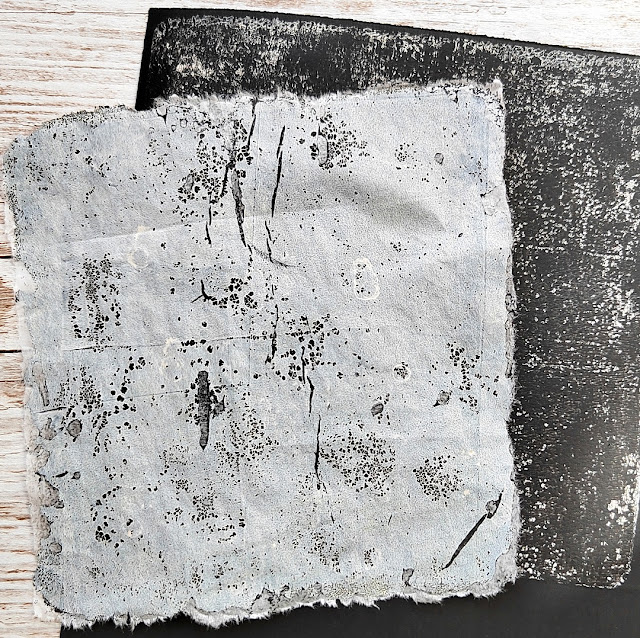Hi everyone, it's Martha (@CraftingMartha) here with you today.
The past few months have been busy because I've been caught up with moving, and many things still need to be sorted out. In fact, some of them haven't resurfaced yet... you'll see later how I had to improvise with something.
There couldn't have been a more fitting topic to bring me back to my creative desk: (Gel) Printing!
The past few months have been busy because I've been caught up with moving, and many things still need to be sorted out. In fact, some of them haven't resurfaced yet... you'll see later how I had to improvise with something.
There couldn't have been a more fitting topic to bring me back to my creative desk: (Gel) Printing!
Following the current theme, which is Nature, I immediately thought of JOFY’s floral-themed stamps and stencils, to create... flowers, of course! LOL.
Having moved into an apartment, I miss having a garden, so what better remedy than creating some super colorful flowers to brighten up my space?
Stay with me and I'll show you how I made my fabric using a Gel Plate, Stencils, Stamps and Fresco Finish Chalk Acrylic.
Having moved into an apartment, I miss having a garden, so what better remedy than creating some super colorful flowers to brighten up my space?
Stay with me and I'll show you how I made my fabric using a Gel Plate, Stencils, Stamps and Fresco Finish Chalk Acrylic.
Since I planned to work on a Gel Plate, I focused more on stencils, choosing PS434 and PS435 along with the JOFY134 stamp set ( you can see the release blog post here https://blog.paperartsy.co.uk/
With various pieces cut from an old white cotton sheet, I'm ready to create my fabric.
I took an old white cotton sheet and cut it into several pieces.
My first attempt at printing on fabric wasn't the best. I'm not sure if it was because I hadn't used a Gel Plate in a while and it seemed a bit dry, or because with temperatures still at 30°C, the paint was drying too quickly, or maybe because fabric isn't as smooth as paper. Either way, the first prints weren't very well-defined. Oddly enough, the results were more satisfying when I cleaned the roller on the fabric LOL.
So, I decided to try using Fresco Finish Chalk Acylics along with the Fresco Finish Drying Retarder (FF112).....
....and this time the result met my expectations, here used with Fresco Finish - Tangerine Twist (FF92).
I played along with several of my favourite Fresco Finish Chalk Acrylic, such as Green Patina ( FF126 ), Cayenne( FF159 ), Mermaid( FF44 ), Slimed( FF137 ), Bubblegum( FF116 ), and I ended up with lots of lovely pieces of fabric.
As I mentioned before, by cleaning the roller I coloured other pieces of fabric which I cut into stripes and decorated using matching Fresco Finish Chalk Acrylic, here for example Lyly the Pink ( FF218 ) through the PS435 stencil....
The time has come to transform these pieces of fabric into petals, I wanted to find an alternative to the sewing machine, but the material at my disposal didn't allow me to do so, sewing and I in general don't really get along very well , then my sewing machine is small and underperforming, but the important thing is to be satisfied LOL.
I traced the shape of a petal on the various pieces of fabric and then cut it out.
I sewed the two parts of the petal, leaving a slit at the bottom, to put some padding.
To give more interest to my flowers I decided to stamp one of the five petals with the numbers of the JOFY134 Stamp Set
For the center of the flower, I tore some even thinner strips than the previous ones and then rolled them up and glued them.
And here are together all the pieces I need.
Trying to figure out how to assemble them.
To assemble the flower I decided to simplify the job and use hot glue... too bad I didn't remember which box the hot glue gun was in. So I used an alternative method, I melted the glue sticks with the embossing heat gun.
Thinking how to 'plant' my flower, I decided to use a glass tealight holder. To make it stand up I cut out two cardboard disks in different sizes, with a hole in the middle, into which insert a wooden stick as the stem. All coloured with Fresco Finish - Granny Smith ( FF1108 ).
This is my almost finished little glass jar.
The fabric stripes decorated in the previous step, were used to embellish the glass jar.
Ladies and gentlemen here are my fabric flowers.
I had fun creating them from scratch, decorating the fabric and then dedicating myself to sewing, which is not my strong point, but if someone else is like me, give it a go, you've seen that in the end you can get a nice result.
Have fun.
Have fun.
Martha xxx
Instagram:craftingmartha
Facebook:Crafting Martha
YouTube:Crafting Martha
Blog:alazyscrapper
Pinterest:alazyscrapper















































































.png)

